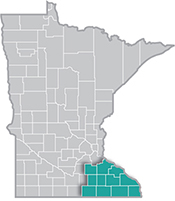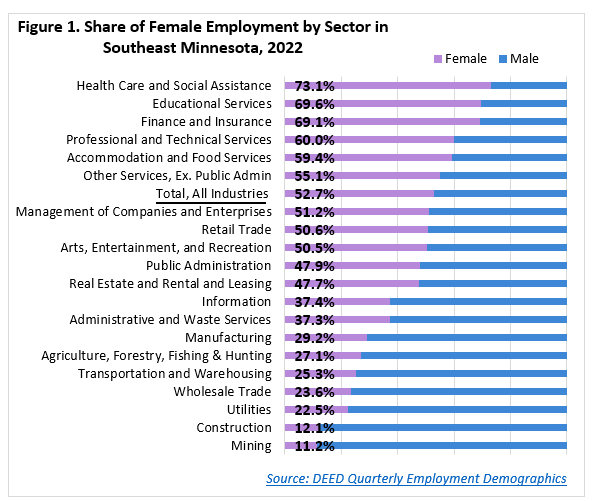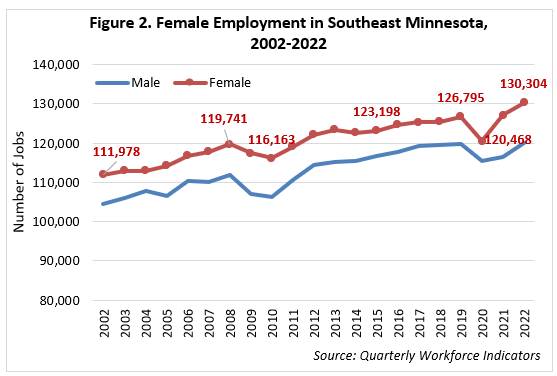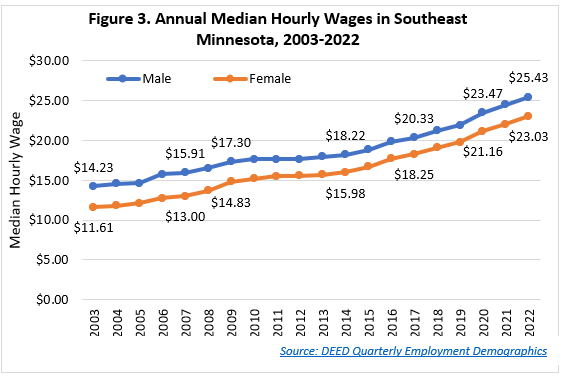 Southeast Minnesota is a health care and agricultural powerhouse. The region is home to the renowned Mayo Clinic and some of the world's most recognized food companies and brands.
Southeast Minnesota is a health care and agricultural powerhouse. The region is home to the renowned Mayo Clinic and some of the world's most recognized food companies and brands.
Advanced manufacturing is especially strong here, with machinery, chemicals, and electronics among the top products.
Want the freshest data delivered by email? Subscribe to our regional newsletters.
8/22/2023 9:00:00 AM
Amanda O'Connell
Women play a vital and multifaceted role in the Southeast Minnesota workforce, contributing significantly to the region's economic development. According to data from our Quarterly Employment Demographics data, over half (52.7%) of jobs in Southeast are held by women.
High shares of female employment are found in service-oriented industries such as Health Care & Social Assistance (73.1%), Educational Services (69.6%), Finance & Insurance (69.1%), and Professional & Technical Services (60%). In contrast, there is a smaller share of women in goods-producing industries such as Mining (11.2%), Construction (12.1%), and Manufacturing (29.2%) (see Figure 1).

The most growth in female employment shares from 2012 was seen in Transportation & Warehousing (+7.1%), Utilities (+5.3%), and Agriculture, Forestry, Fishing, & Hunting (+3.5%). Since 2012, the largest decreases in female employment shares were in Information (-8.2%), Health Care & Social Assistance (-2.7%), and Other Services (-2.1%).
Over the past two decades, the employment landscape for women in Southeast Minnesota has experienced many changes (See Figure 2). In 2002, women held 111,978 jobs, a number that was steadily increasing until 2008, when it peaked at 119,741 jobs. However, the Great Recession caused a downturn, resulting in a decline of -3,578 jobs held by women from 2008 to 2010.

In the recovery from the Great Recession starting 2010, the number of women in the workforce continued to grow, reaching a peak of 126,795 jobs held by women in 2019. The onset of the pandemic in 2020 led to a temporary setback, causing a reduction of -6,327 jobs held by women compared to the previous year. Remarkably, female employment rebounded in 2021, even surpassing pre-pandemic levels with 127,158 jobs held by women. The latest data from 2022 reflects a continued upward trend, with 130,304 women contributing to the workforce in Southeast Minnesota.
In 2022, the median hours worked for women across all industries totaled 406 hours per quarter, equivalent to approximately 31.2 hours per week. This marked an increase of 2.3 hours from 2003, in addition to the gain in female jobholders. Variations in median weekly working hours are evident across different industries. For instance, women employed in Utilities and Management of Companies & Enterprises reported a median of 40 hours worked per week. This was closely followed by the Manufacturing industry, with a median of 37.9 hours, and Finance & Insurance industry, with a median of 37.6 hours.
Conversely, certain industries displayed notably lower median hours for women per week. Specifically, women working in the Arts, Entertainment & Recreation industry recorded a median of only 7.5 hours worked per week. Similarly, those in the Accommodation & Food Services industry had a median of 10.3 hours, while women in Other Services reported a median of 17.4 hours worked per week. These variations in working hours reflect the diverse demands, job structures, and flexibility prevalent across industries, ultimately influencing female participation in the workforce.
Between 2003 and 2022, median hourly wages for both males and females increased consistently in the region (Figure 3). However, males consistently had higher median hourly wages than females. Although the gap between male and female earnings slightly decreased over time, a disparity remains. This reflects the difference in employment by industry and occupation, but also emphasizes the importance of addressing gender wage disparities.

In Southeast Minnesota, the impact of women on the workforce is undeniable, driving economic growth and diversification across various industries. Their significant presence in service-oriented sectors underscores their pivotal role in providing essential care, education, and professional services. While strides have been made in narrowing the gender pay gap, the persistence of wage discrepancies highlights the ongoing need for concerted efforts to ensure equitable compensation and encourage women to pursue higher paid employment in various industries. Over the past two decades women have demonstrated resilience amid economic downturns and quickly rebounded from setbacks.
Contact Amanda O'Connell, Labor Market Analyst, at amanda.oconnell@state.mn.us.